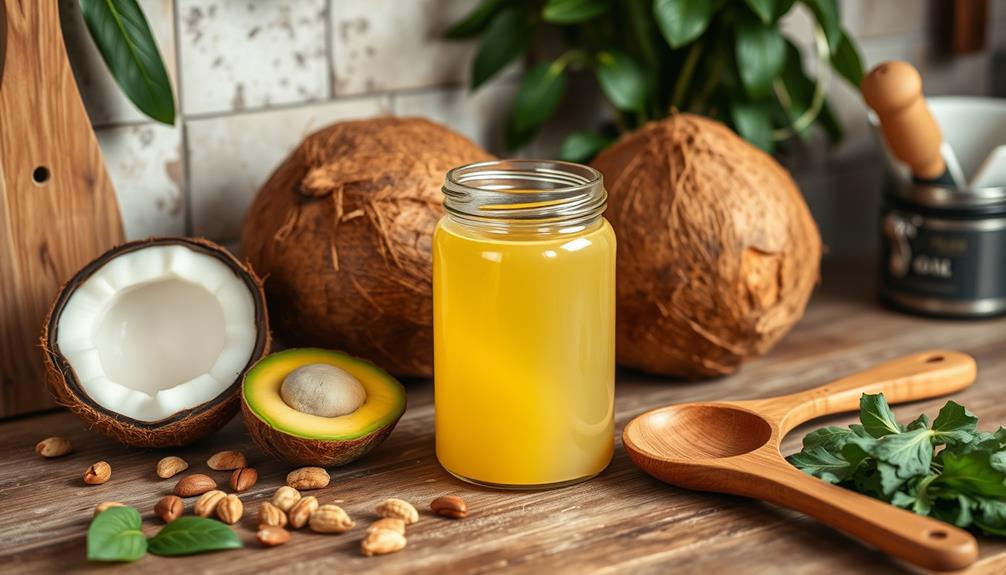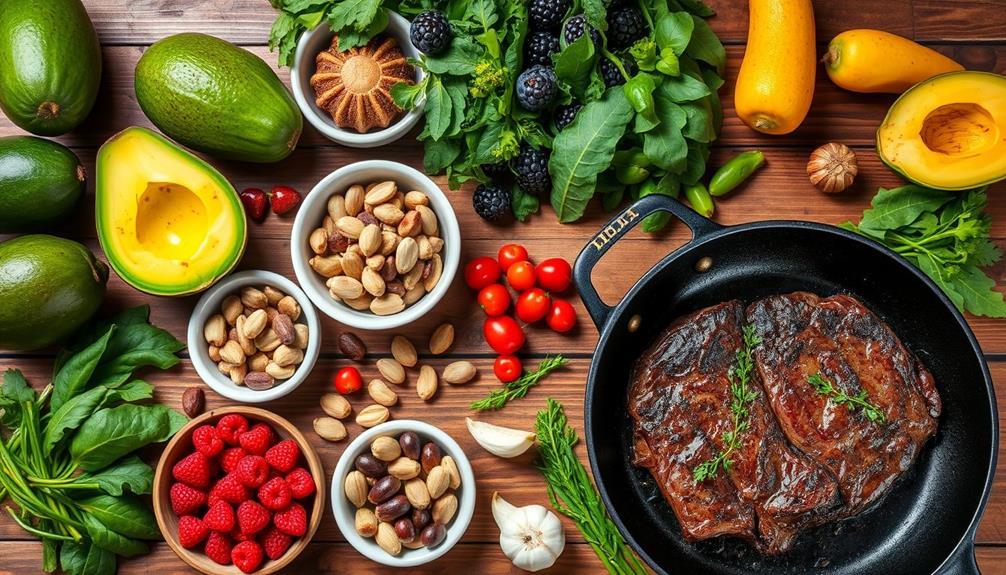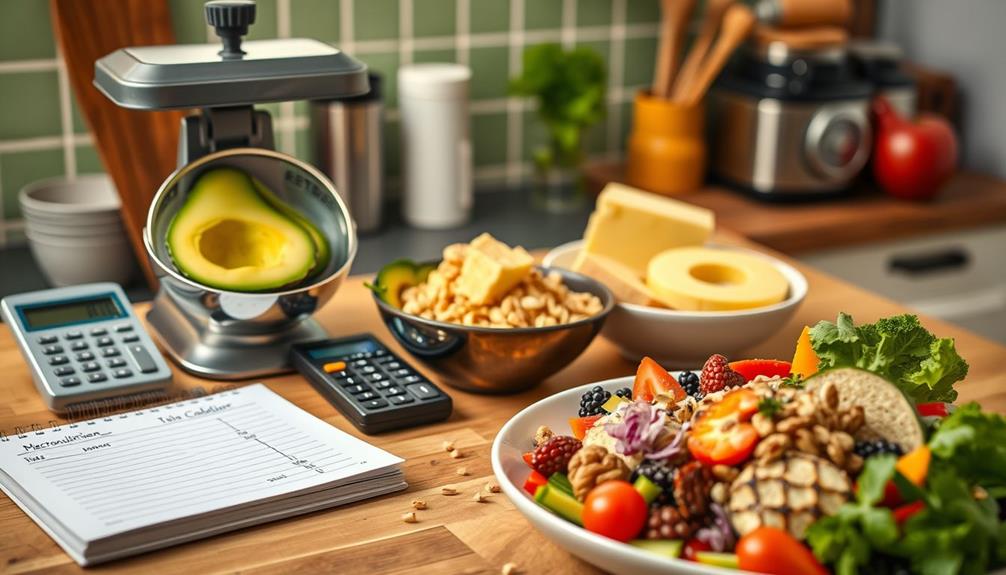To lower uric acid levels on a keto diet, focus on what you eat and drink. Include low-purine vegetables like spinach and bell peppers, along with healthy fats from avocados and olive oil. Opt for fatty fish like salmon, and limit high-purine foods such as red meat and certain seafood. Stay hydrated by drinking 8-10 glasses of water daily, as proper hydration helps your kidneys flush out uric acid. Keep an eye on your uric acid levels through regular monitoring. Making informed choices can greatly impact your health, and there's more to explore about managing uric acid effectively.
Key Takeaways
- Focus on low-purine foods like leafy greens, fatty fish, and full-fat dairy to manage uric acid levels effectively on keto.
- Stay hydrated by drinking 8-10 glasses of water daily to help flush out uric acid and maintain kidney function.
- Limit high-purine foods, including red meat, organ meats, and certain seafood, to prevent spikes in uric acid levels.
- Regularly monitor uric acid levels during the keto diet to identify and address potential increases promptly.
- Incorporate gentle exercise and stress management techniques to promote overall wellness and support uric acid clearance.
Understanding Uric Acid and Gout

Uric acid plays an essential role in your body, but when its levels rise too high, it can lead to gout, a painful arthritis that affects around 6% of adult men and 2% of adult women.
This condition occurs when uric acid crystals form in your joints, causing severe pain, redness, and swelling, often starting in the big toe. Elevated uric acid levels typically result from the breakdown of purines, which are found in many foods, and factors like obesity and high alcohol consumption can increase your risk.
To effectively manage uric acid levels, consider consulting a gout nutrition guide for tailored dietary strategies.
To manage uric acid levels and prevent gout flare-ups, you'll want to adopt effective dietary strategies.
While following a ketogenic diet, it's vital to be mindful of your food choices. Reducing high-purine foods like red meat and seafood can help lower uric acid levels.
Instead, focus on incorporating low-purine foods such as fruits and vegetables into your meals. Staying well-hydrated is also essential, as adequate hydration can aid in flushing out excess uric acid.
Impact of the Keto Diet

The ketogenic diet can considerably impact your uric acid levels, especially during the initial stages. As you shift into ketosis, rapid weight loss and dehydration may lead to increased uric acid levels. This spike can be concerning, particularly if you're managing gout.
However, over time, many individuals find that their uric acid stabilizes and even decreases, potentially reducing flare-ups. Incorporating a balanced diet rich in fruits and vegetables can also play a significant role in supporting kidney health, as these foods help in managing uric acid levels.
While on the keto diet, it's essential to monitor uric acid levels regularly. High-purine foods, such as red meat and certain seafood, are common in keto meal plans and can exacerbate gout symptoms. Yet, ketosis might also offer benefits for gout management. A 2017 study suggested that ketosis could help reduce joint inflammation, thanks to the anti-inflammatory effects of beta-hydroxybutyrate (BOHB), a primary ketone produced during this metabolic state.
To further support your progress, prioritize hydration and make careful food choices. Although there's no direct evidence linking the keto diet to gout management, maintaining hydration and being mindful of purine-rich foods can help mitigate risks associated with elevated uric acid levels.
Additionally, regular check-ups to monitor kidney function can be beneficial for kidney health maintenance.
Foods to Include on Keto

When you're on a keto diet, focusing on foods high in healthy fats and low in purines is essential for managing uric acid levels.
Incorporating a balanced diet rich in effective strategies for weight loss can also contribute to overall health.
Include low-purine vegetables like spinach and bell peppers, along with sources of healthy fats such as avocados and olive oil.
These choices not only support your dietary goals but also help keep uric acid in check.
Foods High in Fats
Incorporating foods high in fats is essential for a successful keto diet, especially if you're looking to manage uric acid levels. Healthy fats not only support your ketogenic lifestyle but also help reduce uric acid levels and alleviate gout symptoms.
Start by adding avocados to your meals; they provide healthy monounsaturated fats and fiber while being low in purines. Additionally, understanding the various brewing methods can enhance your coffee experience, making it easier to enjoy your favorite beverages in moderation.
Olive oil is another staple that boasts anti-inflammatory properties, making it beneficial for those managing gout. Fatty fish like salmon and mackerel are excellent choices, packed with omega-3 fatty acids that further help reduce inflammation and are lower in purines compared to other protein sources.
Snacking on nuts and seeds, such as walnuts and chia seeds, is a great way to incorporate healthy fats and fiber while keeping purine levels low.
Don't forget about full-fat dairy products like cheese and Greek yogurt; they offer beneficial fats and protein and may aid in lowering uric acid levels due to their calcium content.
Low-Purine Vegetable Options
Balancing your keto diet with low-purine vegetable options is essential for managing uric acid levels while enjoying diverse flavors. Incorporate low-purine vegetables like bell peppers, zucchini, and kale into your meals. These options aren't only low in purines but also nutrient-rich, providing vitamins and antioxidants to support your health.
Additionally, including essential oils for inflammation relief can complement your diet, helping to further reduce discomfort associated with high uric acid levels.
Leafy greens, such as spinach and lettuce, should be consumed in moderation due to their moderate purine content. However, non-starchy vegetables like cucumbers and cauliflower offer excellent low-purine choices. You can also enjoy cruciferous vegetables like broccoli and Brussels sprouts, which can help reduce inflammation and may alleviate gout symptoms.
Don't forget about avocados! They're packed with healthy fats and low in purines, making them a great addition to your keto diet without raising uric acid levels.
While cauliflower and asparagus contain some purines, they can still be included in moderation, contributing to a diverse and nutritious meal plan. By focusing on these low-purine vegetables, you'll enhance your keto diet while effectively managing uric acid and promoting overall wellness.
Foods to Avoid on Keto

Avoiding certain foods is essential for successfully managing uric acid levels while on a keto diet. By steering clear of specific items, you can minimize the risk of gout flare-ups and effectively lower your uric acid levels.
Additionally, maintaining a balanced diet can also help with budgeting for health by allowing you to allocate resources for healthier food choices.
Here's a list of foods to avoid:
- High-purine foods: Limit red meat, organ meats (like liver and kidneys), and certain seafood (like sardines and anchovies).
- Alcohol consumption: Be cautious, especially with beer and spirits, as they're linked to increased uric acid levels.
- Sugary foods: Avoid foods and beverages high in fructose, which can elevate uric acid levels and counteract keto benefits.
- Legumes: Minimize or eliminate peas, lentils, and other legumes, as they're high in purines.
- Certain vegetables: Consume spinach and asparagus in moderation since they contain moderate purines.
Hydration and Lifestyle Tips

Staying properly hydrated plays an essential role in managing uric acid levels while on a keto diet. Aim for at least 8-10 glasses of water daily to help flush out uric acid effectively. Dehydration can increase uric acid concentration, so keeping your hydration levels in check is vital.
Regular exercise not only supports weight management but also promotes better metabolism and aids in uric acid clearance. Incorporating gentle stretching before bedtime can also enhance relaxation and improve sleep quality, which is important for overall health. Try to incorporate at least 150 minutes of moderate exercise each week.
In addition to hydration, focus on incorporating electrolyte-rich foods into your meals. Leafy greens and avocados are excellent choices that can help maintain hydration and balance, essential for proper kidney function and uric acid excretion.
Yoga for back pain also emphasizes the importance of gentle movement, which can be beneficial for overall wellness. Monitor your urine color; a pale yellow indicates good hydration, while darker shades suggest you need to drink more fluids.
Don't overlook the importance of stress management and a consistent sleep schedule. Both can greatly influence inflammation and overall health, contributing to healthy uric acid levels.
Monitoring Your Uric Acid Levels

Monitoring your uric acid levels is essential when you're on a keto diet, especially since rapid weight loss can temporarily raise these levels.
Individuals with certain mental health conditions, such as Borderline Personality Disorder (BPD), may experience heightened emotional responses that can impact dietary choices and adherence.
Regular testing helps you identify any risk factors for gout flare-ups, allowing you to adjust your diet accordingly.
Importance of Regular Testing
Regular testing of your uric acid levels is essential when following a keto diet, especially during the initial adaptation phase. Fluctuations in uric acid can lead to gout attacks, so keeping an eye on these levels is vital.
Early detection is important for managing potential health issues, similar to how mammography aims to detect breast cancer early for better treatment outcomes.
Here's why monitoring is important:
- Identify Increases: Regular testing helps spot significant increases due to high-purine foods in your diet.
- Timely Dietary Adjustments: If your uric acid levels rise, you can make necessary dietary adjustments promptly.
- Initial Ketosis Awareness: During the first six weeks, initial ketosis may cause transient spikes in uric acid; testing helps track these changes.
- Long-term Effects Assessment: Monitoring uric acid levels contributes to understanding the long-term effects of the keto diet on gout management.
- Healthcare Provider Consultation: Collaborating with a healthcare provider for regular testing enhances your gout management strategy.
Identifying Risk Factors
When you're on a keto diet, understanding the risk factors that can affect your uric acid levels is essential. Initial ketosis often leads to rapid weight loss and metabolic changes, which can cause a temporary spike in uric acid.
Additionally, incorporating strategies for investment strategies in precious metals can help you manage your long-term financial health, just as monitoring uric acid levels aids in your physical health. It's vital to monitor your uric acid levels regularly, especially if you have a history of gout or elevated uric acid. Regular blood tests will help you keep track; normal levels range from 3.5 to 7.2 mg/dL for men and 2.6 to 6.0 mg/dL for women.
Your dietary choices also play a significant role. High-protein foods can be rich in purines, which may increase uric acid. Daily monitoring of your purine intake will help you manage your levels effectively while sticking to the keto diet.
Don't forget the importance of hydration—adequate fluid intake helps dilute uric acid and promotes its excretion through urine. By staying aware of these risk factors and making informed choices, you can enjoy the benefits of the keto diet while minimizing the risk of elevated uric acid levels.
Frequently Asked Questions
Does a Keto Diet Cause High Uric Acid?
Yes, a keto diet can cause high uric acid initially due to rapid weight loss and dehydration. It often normalizes over time, but if you have gout, you might experience more flare-ups during this change.
What Foods Clear Out Uric Acid?
Did you know that eating cherries can lower uric acid levels by up to 35%? Incorporating vitamin C-rich foods, low-fat dairy, hydration, and whole grains into your diet can help clear out excess uric acid effectively.
What Is the Best Drink to Lower Uric Acid?
To lower uric acid, drink plenty of water to stay hydrated. Consider cherry juice for its anti-inflammatory properties, and enjoy coffee or green tea for their antioxidants. Avoid sugary drinks, as they raise uric acid levels.
Does Intermittent Fasting Reduce Uric Acid?
Yes, intermittent fasting can reduce uric acid. It improves insulin sensitivity, promotes autophagy, and may lead to weight loss. Just remember to consult your healthcare provider for personalized advice on managing your levels effectively.
Conclusion
Incorporating a keto diet can be a game-changer for lowering uric acid levels and managing gout. By focusing on the right foods and avoiding those that trigger spikes, you can create a balanced approach that supports your health. Remember, staying hydrated and monitoring your levels is key. So, as you begin this journey, you'll feel like a dietary superhero, armed with the knowledge to conquer uric acid and reclaim your well-being.









